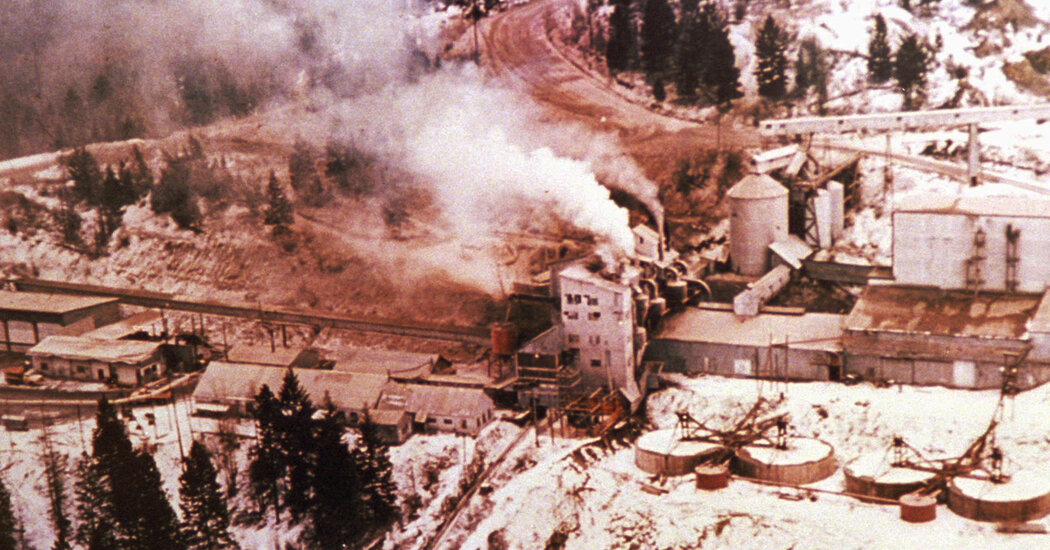The verdict was the first of hundreds of cases pending against the company hired to oversee medical care and safety for workers at a mine and mill in Libby, Mont.
HELENA, Mont. — For years, workers employed by W.R. Grace & Company in the mountain town of Libby, Mont., worked in a dust-choked vermiculite mine and mill, not knowing that the raw material for insulation they were mining also contained deadly asbestos fibers.
The company, however, did know. Senior managers made the decision to keep the workers in the dark, according to evidence presented in court over the past several weeks, even as the workers gradually lost their ability to breathe.
The plan, documents and witnesses suggested, kept employees from knowing about early signs of lung scarring that would lead to asbestosis, lung cancer and mesothelioma — until they retired and could no longer make costly workers’ compensation claims.
Last week, a jury in State District Court in Great Falls, Mont., awarded a former laborer $36.5 million in damages, agreeing that the mining company’s workers’ compensation insurer, which also consulted on safety and medical issues for W.R. Grace, had failed to warn workers that they were at risk of deadly illness. Hundreds more cases against the insurer, Maryland Casualty Company, which is now part of Zurich Insurance, are still awaiting trial.
Many former workers and their families have died of asbestos-related illnesses, and others say they have been living with the possibility of a painful death for years based on their exposure during the 1960s and early 1970s.
“It scares me,” the plaintiff in the current case, Ralph Hutt, said in a video deposition from his home in Roseburg, Ore. He said that he had faced increasing difficulty breathing and that there was no cure. “That’s one way I don’t want to go,” he said. “Let someone shoot me. I don’t want to be dunked underwater or strangled. That’s what it feels like.”
Asbestos poisoning is the subject of the nation’s longest-running mass tort litigation and one of the most expensive. The Environmental Working Group estimates that 12,000 to 15,000 people die from asbestos-related disease each year.
The first cases in Libby, a town of 2,700 people about 200 miles northwest of Missoula, were filed in the mid-1990s. W.R. Grace paid out about several million dollars in claims before declaring bankruptcy in 2001.
But previous awards were in the hundreds of thousands of dollars; no one had received anything close to the recent verdict. The difference with the recent lawsuit and others to come against Maryland Casualty is that the company’s safety and medical professionals had a duty to protect the workers’ health, yet failed to warn them of the hazards, or in some cases that their lungs showed early signs of damage, said Allan McGarvey, a lawyer in Kalispell, Mont., who has represented Mr. Hutt and many other workers over the past 30 years.
“It was a scheme to cheat these workers,” he said. “They wanted to keep them on the job until retirement to preclude the high cost of workmen’s compensation payouts and didn’t tell them.”
Zurich Insurance declined to comment on the verdict, but in court the company argued that it had strongly recommended reducing the levels of toxic dust at the site but W.R. Grace had failed to do so. It also said the insurers had no way of knowing that workers were not always wearing respirators that might protect them from asbestos fibers.
A key issue was whether the statute of limitations had run out on claims like Mr. Hutt’s — an issue decided in favor of the plaintiff.
It took years for workers to begin to understand the extent of their exposure and the risk to their health, Mr. McGarvey said.
“The workers couldn’t smell it, they couldn’t taste it, it didn’t burn,” he said. “There was no indication it was anything more than plain old dust.” But medical studies undertaken by Libby physicians in the 1960s showed that 37 percent of all workers had the beginning of hidden disease. In long-term workers, 92 percent had asbestos-related illness.
Maryland Casualty doctors and technicians took annual X-rays of the workers’ lungs and could see the scarring, but they withheld that information from the workers, according to evidence presented at trial. This included a 1967 memo from a Maryland Casualty lawyer, S. Y. Larrick, in which he urged settling with a worker who had filed a workers’ compensation claim rather than taking the case to a hearing. “I would very much like to avoid having evidence presented by the opposing party which would reveal the extent and severity of the problem with which we are concerned,” he wrote.
Mr. Hutt worked for W.R. Grace for 18 months in 1968 and 1969 and was diagnosed with asbestosis in 2002. When he went to work there in the dry mill at the age of 27, he said in his deposition, his boss handed him “a broom and a snow shovel and put him to work sweeping.” Workers did not wear masks, he said, because they got clogged up too quickly.
At least 400 deaths have been documented from asbestos-related causes in Libby and more than 2,400 people have been diagnosed with asbestos-related illnesses at the Center for Asbestos Related Disease clinic established to treat people in the town.
The contamination affected far more than the workers. The U.S. government in 2009 called it “the worst case of industrial poisoning of a whole community in American history.”
W.R. Grace began mining a deposit of vermiculite on a forested peak called Zonolite Mountain near Libby in the 1960s. The relatively harmless mineral, known commercially as Zonolite, was used in attic insulation until the 1980s. But a naturally occurring type of deadly asbestos was found in the same deposit.
The mine produced seven to nine tons of dust a day for 10 years during the time Maryland Casualty was part of the operations, and asbestos sometimes made up 60 to 80 percent of the airborne dust. Dust not only billowed everywhere at the mine and mill, but toxic levels filled the air over much of the small town.
W.R. Grace and Maryland Casualty kept that fact hidden from workers, according to the lawsuit. In 1990, the mine closed. Illness, however, continued to spread.
Few outside Libby knew what was occurring until 1998, when a resident named Gayla Benefield sued W.R. Grace after her mother, Margaret Vatland, died of what community residents had come to call “take home” asbestosis — her father, Perley Vatland, had brought asbestos home on his work clothes and contaminated his wife and children, including Ms. Benefield. “Miners went to work at the mine and came home dusty,” Ms. Benefield said in an interview. “It was a badge of honor.”
Ms. Benefield won her case, and in 1999, the Environmental Protection Agency began investigating the impacts of toxic asbestos pollution. Three years later, the agency placed Libby on its National Priorities List as a Superfund site, and in 2009 it declared a public health emergency to allow residents to receive federal funds for health care, the first such designation in E.P.A. history.
Government workers who were called in for remediation found asbestos almost everywhere: in the lungs of the workers and their families; in tailings piles around town; on the baseball field and high school running tracks where the company had donated material for ground cover. “They polluted the whole damn town,” Ms. Benefield said.
The painful effects continue to unfold slowly — it takes decades for asbestos illnesses to show up, and children who played baseball or ran on tracks with asbestos in the air are only now becoming ill.
Ms. Benefield was diagnosed with asbestosis and has been on supplemental oxygen full-time since 2015, though she still golfs and bowls, she says. “All my aunts and uncles died from this,” she said. “Four of five of my children have been diagnosed.”
W.R. Grace and three of its officers were tried in criminal court in 2009 for knowingly contaminating the small town and then conspiring to keep it under wraps. They were acquitted after the company argued that its executives had engaged not in a cover-up, but a good-faith effort that went on for years to make the mine safer.
But in an opinion in 2020 clearing the way for Mr. Hutt’s case to go to trial, the Montana Supreme Court found that Grace’s workers’ compensation insurer “engaged in affirmative actions to conceal the asbestos exposure risk and worker injuries” in order to avoid liability, knowing that it could take years for the illnesses to become apparent.
Facing tens of thousands of lawsuits, W.R. Grace declared bankruptcy in 2001 and set up a trust to evaluate claims and settle them for pennies on the dollar. Maryland Casualty initially claimed it was covered under the bankruptcy, but a court ruled that the company had to face the lawsuits independently. The case last week established the parameters for the rest of the cases to follow.
The company has not said whether it will appeal the verdict.
Libby is still a Superfund site. Since cleanup began in 2000, more than 2,600 contaminated locations — yards, tailings piles and parks — have been dug up, with clean soil brought in and contaminants hauled away.
The amount of asbestos fibers in the air in downtown Libby, the E.P.A. reported recently, “is now nearly 100,000 times lower than when the vermiculite mine and mill were operating.”
But Mr. McGarvey said the town already had paid the price. “For the last 20 years as I have been fighting this,” he said, “I get an obituary notice about one of my clients just about every month.”



























